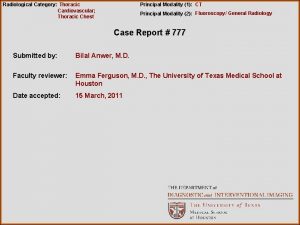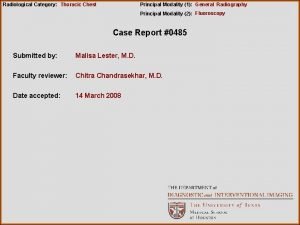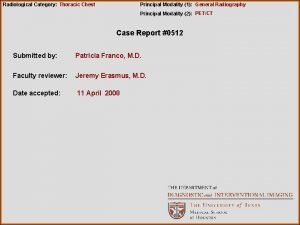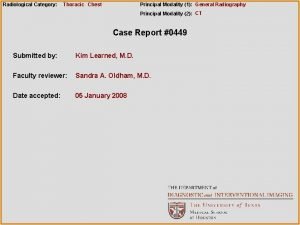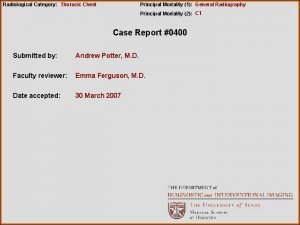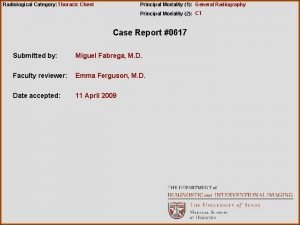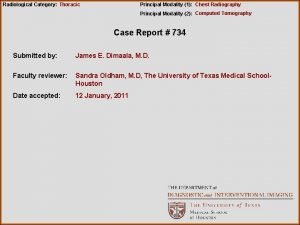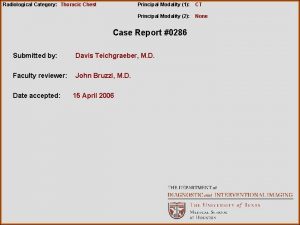Radiological Category Principal Modality 1 CT Thoracic Chest









- Slides: 9

Radiological Category: Principal Modality (1): CT Thoracic Chest Principal Modality (2): General Radiography Case Report #0301 Submitted by: Erin Winston, M. D. Faculty reviewer: Emma Ferguson, M. D. Date accepted: 15 April 2006

Case History 49 y/o female with gastric carcinoma.

Radiological Presentations

2 years later

Radiological Presentations

Test Your Diagnosis Which one of the following is your choice for the appropriate diagnosis? After your selection, go to next page. • Lymphoma that involves the lung • Sarcoidosis • Lymphangitic carcinomatosis • Interstitial pulmonary edema • Kaposi’s sarcoma • Viral and mycoplasma pneumonia

Findings and Differentials Findings: X-ray: Diffuse, fine reticular nodular opacities without lymphadenopathy or architectural distortion. Appear chronic. Moderate bilateral pleural effusions. CT: 1. Smooth linear-nodular axial interstitial thickening along the brochovascular bundles. 2. Septal thickening. 3. Identification of polygonal structures representing secondary pulmonary lobules. Differentials: • Lymphangitic carcinomatosis • Sarcoidosis • Pulmonary edema • Lymphoma involving lung parenchyma • Kaposi’s sarcoma

Discussion Sarcoidosis- classic pattern is small NODULES along the axial interstitium emanating from the hila along bronchovascular bundles Primary pulmonary Hodgkin’s disease – extremely uncommon. When there is lung involvement, disease is usually widespread with bulky intrathoracic lymphadenopathy. Pattern is similar to sarcoidosis and Kapsosi’s sarcoma with illdefined masses and NODULES emanating from the hila in an axial distribution Kaposi’s sarcoma – NODULAR or more confluent opacities in an axial distribution with thickening of the bronchovascular bundles. Pleural effusion and adenopathy are frequent features. Interstitial pulmonary edema – LINEAR opacities along the axial interstitium. Other signs of volume overload. An acute process.

Diagnosis Lymphangitic carcinomatosis: CXR pattern is diffuse reticular nodular or linear opacities, septal lines, hilar and mediastinal adenopathy, and pelural effusions. HRCT pattern reflects the lymphatic distribution. 1) Smooth or nodular thickening along bronchovascular bundles. 2) Septal thickening. 3) Identification of secondary pulmonary lobules (polyhedrons). Findings are non-specific. But a history of cancer makes it pathognomonic. Occurs most commonly in carinomas of lung, breast, stomach, and colon, and metastatic adenocarcinoma of unknown primary sites.
 Erate pa
Erate pa Tennessee division of radiological health
Tennessee division of radiological health Center for devices and radiological health
Center for devices and radiological health National radiological emergency preparedness conference
National radiological emergency preparedness conference Radiological dispersal device
Radiological dispersal device Entity class in software engineering
Entity class in software engineering Deontic and epistemic modality exercises
Deontic and epistemic modality exercises Stefan savi
Stefan savi Modality in software engineering
Modality in software engineering Cardinality and modality in database
Cardinality and modality in database










